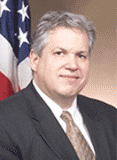
Flickr/<a href="http://www.flickr.com/photos/jded/3517427116/">JD_WMWM</a> (<a href="http://www.creativecommons.org">Creative Commons</a>).
With his soon-to-be-released book, Karl Rove is trying to mount something of a rear-guard action in the war over George W. Bush’s legacy. According to the AP, which has obtained a copy of the book, Rove
blames himself for not pushing back against claims that President George W. Bush had taken the country to war under false pretenses, calling it one of the worst mistakes he made during the Bush presidency. The president, he adds, did not knowingly mislead the American public about the existence of [weapons of mass destruction].
And The New York Times reports that in the book, which will hit stores on Tuesday, Rove writes that his failure to counter the narrative that “Bush lied” was “one of the biggest mistakes of the Bush years.” Rove adds, “did Bush lie us into war? Absolutely not.”
Here we go again: Did Bush grease the way to war with lies? Having written two books on the subject—The Lies of George W. Bush and (with Michael Isikoff) Hubris: The Inside Story of Spin, Scandal, and the Selling of the Iraq War—I have some skin in this game.
Let’s cut to the bottom line: prior to the Iraq war, US intelligence generally produced faulty information overstating Saddam Hussein’s WMD capabilities, which were actually nonexistent. But Bush and his crew purposefully and callously overstated these overstatements—and made dramatic and untrue assertions unconnected to the flawed intelligence—in order to whip up popular support for the invasion of Iraq. Mother Jones has produced a timeline that lists the false Bush administration assertions. And to remind Rove—and book reviewers—here’s a limited sampling of notable whoppers, reported in my books and elsewhere.
- When Bush issued his ultimatum to Saddam Hussein on March 17, 2003, he declared, “Intelligence gathered by this and other governments leaves no doubt that the Iraq regime continues to possess and conceal some of the most lethal weapons ever devised.” But there was doubt—and plenty of it. Intelligence analysts had registered uncertainty regarding key elements of Bush’s case for war—such as whether Iraq had attempted to obtain uranium in Niger, and whether it had purchased aluminum tubes for an enrichment process to make material for nuclear weapons. Moreover, the doubters were correct.
- Seven months earlier, Vice President Dick Cheney similarly said in a speech, “Simply stated, there’s no doubt that Saddam Hussein now has weapons of mass destruction. There is no doubt he is amassing them to use against our friends, against our allies, and against us.” But there was no intelligence suggesting that Saddam’s intention was to beef up his WMD arsenal so he could deploy it against the United States—which would have been a suicidal act. In fact, the existing intelligence indicated Saddam was not interested in a WMD showdown with the United States.
- During an October 7, 2002, speech in Cincinnati, Bush declared that UN inspectors had “concluded” that Iraq in the 1990s had actually produced “two to four times” the 30,000 liters of anthrax and other deadly biological agents than it had acknowledged making. Bush went on: “This is a massive stockpile of biological weapons that has never been accounted for, and capable of killing millions.” But UN inspectors had concluded no such thing. They had reported destroying key facilities Iraq had used to develop chemical, biological, and nuclear weapons. The inspectors had encountered discrepancies in the accounting of Iraq’s weapons and WMD material and had noted that Iraq could have produced more weapons than the inspectors had uncovered. Bush was misstating the facts to turn a possible stockpile of WMDs into an actual arsenal.
- Throughout the fall of 2002 and the winter of 2003, Bush and his aides insisted Iraq was loaded with WMDs. At one point, Defense Secretary Donald Rumsfeld huffed, “There’s no debate in the world as to whether they have those weapons…We all know that. A trained ape knows that.” On January 7, 2003, Rumsfeld declared, “They currently have chemical and biological weapons.” Yet a September 2002 report by the Defense Intelligence Agency said, “There is no reliable information on whether Iraq is producing or stockpiling chemical weapons, or where Iraq has—or will—establish its chemical warfare agent production facilities.” A national intelligence estimate produced about that time did assert, “Baghdad has chemical and biological weapons.” The point is that contradictory information existed, yet Bush and his crew chose to ignore any data that undermined their contention that Saddam was up to his neck in WMDs.
- At a September 7, 2002, joint news conference with British Prime Minister Tony Blair, Bush said that a 1998 International Atomic Energy Agency report had found that Iraq was “six months away from developing a [nuclear] weapon. I don’t know what more evidence we need.” But there was no such IAEA report. And in 1998, the IAEA had reported there were “no indications” that Iraq was producing nuclear weapons. Bush had concocted a nonexistent report to bolster the case for war.
- On November 7, 2002, Bush said Saddam “is a threat because he’s dealing with Al Qaeda.” Yet as the 9/11 Commission later noted, there had been no intelligence confirming contacts between Iraq and Al Qaeda that added up to an operational relationship. (On September 26, 2002, Rumsfeld said that he had “bullet-proof” evidence that Saddam was tied to Osama bin Laden. He never produced that evidence. In March 2003, Cheney claimed Saddam had a “long-standing relationship” with Al Qaeda. He didn’t.)
- At a December 31, 2002, press conference, Bush asserted, “We don’t know whether or not [Saddam] has a nuclear weapon.” But there was no intelligence at the time suggesting that the Iraqi dictator might already possess nuclear weapons. The faulty national intelligence estimate produced in October 2002 had errantly declared that Iraq was “reconstituting” its nuclear weapons program but it had also concluded Iraq had no nuclear weapons and would not be able to produce one for years. Bush had no basis for suggesting Saddam could already be nuclear-armed. Yet he did so.
I could go on. Remember Colin Powell’s lengthy UN presentation? Practically every relevant fact in it proved to be false. Rove can argue that in the run-up to the war, Bush and the others believed what they were saying about Iraq’s WMDs. But Bush and his crowd demonstrated a profound disinterest in sorting out the truth. They made no effort to distinguish between known facts and convenient suppositions. They exaggerated. They trumped up unconfirmed pieces of information. They presented rosy assumptions. They overlooked or discounted data that didn’t advance the cause.
It was a PR campaign girded with misrepresentations and false statements. Rove contends that his old boss did not knowingly bamboozle the public. (Bush, though, did in a January 2003 meeting with Tony Blair raise the idea of staging an incident—in which US reconnaissance planes painted in UN colors would fly over Iraq and try to draw fire—to provoke an excuse for war.) But Bush, Cheney, and other administration aides exercised a thoroughly reckless disregard for the truth, as they pushed an utterly phony and over-the-top case for invading Iraq.
As Rove makes the rounds on his book tour, he ought to be pressed on all this. There is no doubt that the Bush posse mischaracterized what was known and not known about WMDs in Iraq. It was easy—and useful—for them to do so, for they didn’t care to get this right. (After all, as Rove writes, the Iraq war would have likely not occurred without the WMD argument: “Congress was very unlikely to have supported the use-of-force resolution without the WMD threat.”) Bush and his aides, Rove included, were not looking to lead an informed debate based on the best information available; they were aiming to start a war. Almost by any means necessary. They spun the nation into Iraq—and now Rove is spinning to cover that up.










